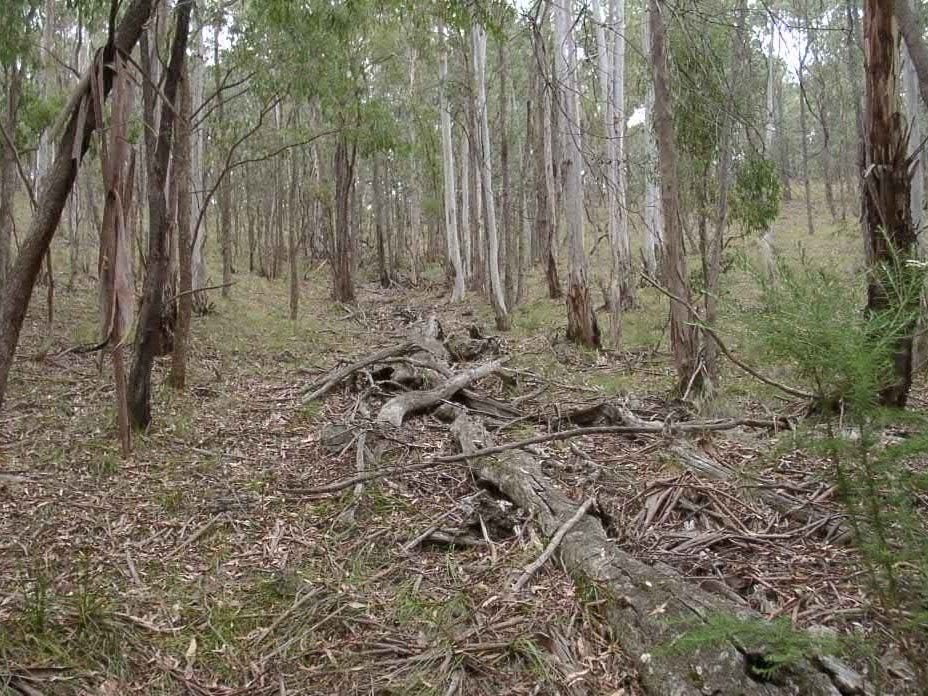
Smiths Gully
Landcare Group

Flora of Smiths Gully
Vegetation Communities As you walk the trail the Dry Sclerophyll Forest of the easterly slopes gives way to Valley Sclerophyll Forest in the Silurian-derived sedimentary soil of the gullies.
The predominant over-story Eucalyptus are: Long-leaf Box, Red Stringybark, Yellow Box, Messmate, Red Box, Narrow-leaf Peppermint and Candlebark. In the wetter gullies and the creek bed stands of Swamp Gum and Manna Gum vary the vegetation.
The Acacia Species you see are: Blackwood, Black and Silver Wattles (mainly at the St Andrews end of trail) and Prickly Moses.
The predominant tall shrubs are: Sweet Bursaria, Dogwood, Pomaderris, Hop Goodenia and Burgan.
Of the low shrubs and ground covering plants Lomandra (Mat Rush) is predominant in the moist and shaded areas, and is of importance not only as habitat for birds, marsupials and reptiles but as competition against invasive weeds.
As the woodland forest opens out at the St Andrews end of the trail, Kangaroo, Wallaby and Tussock Grasses replace the Rushes, Sedge, Maiden-hair Fern, Violets and Weeping Grass as ground cover.
Wild Flowers In the Spring there is a spectacular array of Wild Flowers, the best display of these is in the open grassland at St Andrews. They include: Chocolate, Flax and Bulbine Lilies, Bush Peas, Rice flowers, Buttercups, Everlasting Daisies, Blue Pin-Cushions, Trigger Plants, Early Nancy, Milkmaids, Blue Bells, Orchids, and Sundews.





Fauna of Smiths Gully
Fauna This rich habitat supports a great diversity of native animals: Black Wallaby, Eastern Grey Kangaroo, Common Wombat, Short-beaked Echidna, Brushtail and Ringtail Possum, Long-nosed Bandicoot... just to name a few.
Some of the birds you are likely to see and hear, depending on the season are: Eastern Rosella, Galah, Kookaburra, Magpie, Yellow, Scarlet and Flame Robin, White-browed Scrub and Supurb Fairy Wren, Thornbill, Silver-eye, Grey Fantail, Spotted and Striated Pardalote, White-Naped Honeyeater, Golden Whistler, Olive-backed Oriel, Sulphur Crested Cockatoo, Fantailed Cuckoo, Black-faced Cuckoo-Shrike and Grey Shrike-Thrush.
The Silver and Black Wattles provide sap for the nocturnal Sugar Gliders and Feather-Tail Gliders. The Bats find day-time cover and winter hibernation hide-aways under the stringy bark and hospitable hollows of Eucalyptus species.
Raucous flocks of Yellow-tailed Black and Gang Gang Cockatoos disturb the tranquility as they pass through and noisy families of White-winged Choughs and Grey Currawongs are also regular visitors.
A variety of water birds including Wood Ducks, White-faced Heron, Straw-necked Ibis and Sacred Kingfisher frequent the creek bed and water holes.
In Spring and Summer you are most likely to see the Common Imperial Blue Butterfly and at least one of the five species of Skipper Butterflies recorded in this region. Mat Rush, Sedge, Tussock Grass, Bursaria, Dogwood, Mistletoe, Burgan and Blackwood Wattle support the many species of butterflies seen along this trail.





Conserve our biodiversity
We aim to protect and enhance our environmental biodiversity of our local area by planting local plants, and removing invasive species.
Knowledge sharing
We continue to learn and share our knowledge so we may continue to grow and ready the next generation of environmentalists.
Celebrate Cultural, Historic and Biodiversity Significance
We celebrate Cultural, Historic and Biodiversity Significance.
Statement of Purpose
Smiths Gully Landcare aims to conserve Indigenous Flora and Fauna by protecting, enhancing biodiversity values and advocating the protection of our beautiful local Flora and Fauna. We strive to engender a sprit of co-operation between a diversity of land users and encourage sustainable land management practices. We will promote awareness, celebrate and protect areas of cultural, historic and biodiversity significance and embrace knowledge sharing.
